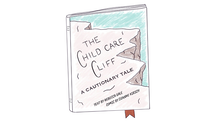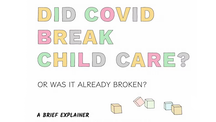In 2023, EdSurge published a record number of stories on early care and education — the most we’ve run since we began covering the age group nearly five years ago.
So this year, for the first time, we’re bringing you a list of the stories that resonated most with you, our readers. Below, you’ll find our 10 most popular early childhood stories from the last 12 months, which can loosely be divided into two camps.
In one, we have several stories that dive into the dire conditions of the early learning sector today and what’s at stake now that pandemic-era federal funding has expired. Why is this field so fractured and fragile? What happens now that early learning programs have gone over the “fiscal cliff”?
In the other, we have stories of hope and resilience. In these, our reporters and contributors explore possible solutions and promising innovations underway that may offer a salve to this struggling field, now that broad federal investment in early education is highly improbable. These stories include local efforts, private sector contributions and public-private partnerships that, in many cases, can be scaled up.
Check out our most-read stories of 2023 below. And if 10 isn’t enough, you can read all of our early childhood coverage here.
The 10 Most Popular ECE Stories, in Descending Order
10. How a Small Town in a Red State Rallied Around Universal Preschool
By Emily Tate Sullivan

In 2017, kindergarten readiness rates in American Falls, a one-stoplight farming community in conservative Idaho, hit “rock bottom.” Then a school leader launched a campaign encouraging families to “read, talk, play” with children every single day. That simple mantra became a movement, and today, the town has embraced a goal of universal preschool. Our reporter visited American Falls to find out exactly how this transformation unfolded.
9. The Child Care Cliff, A Cautionary Tale
By Rebecca Gale and Dianne Kirsch

What is the child care cliff, and why should people care? Those are the questions Rebecca Gale and Dianne Kirsch teamed up to explore with their graphic story. In a series of illustrations, the duo unpacks the child care cliff, what happens after federal funding for child care runs out and why we need to support efforts to invest in child care infrastructure.
8. Child Care Programs See Closures, Resignations and Tuition Hikes After Federal Funding Expires
By Emily Tate Sullivan

It’s been a few months since $24 billion in child care stabilization grants expired, sending the nation’s early care and education programs over the so-called fiscal cliff. Without a stopgap funding solution, the problems those dollars helped paper over are resurfacing. We spoke with educators and families in West Virginia to understand what that historic funding enabled them to do — and the “impossible choices” they now face.
7. What to Know About the Growing Popularity of Employer-Sponsored Child Care
By Emily Tate Sullivan

Employers are increasingly getting involved in child care, offering perks such as on-site care and monthly stipends to offset costs. Last May, EdSurge published an in-depth story about this growing trend and the controversy surrounding it. The next month, we ran a separate story about the top takeaways from our reporting on employer-sponsored child care — our “TL;DR” version.
6. We Need Better Pathways for Becoming an Early Childhood Teacher
By Jay Lee

“Access to high-quality early childhood education is among the most powerful, proven ways to close equity gaps and support communities,” writes Jay Lee, an early childhood teacher in Oakland, California. But there aren’t enough teachers. Why, then, Lee wonders, is it so difficult to become a certified early childhood teacher? In his essay, Lee explores why building inclusive, accessible pathways is key.
5. Federal Government Launches First-of-Its-Kind Center for Early Childhood Workforce
By Emily Tate Sullivan

Challenges facing the early care and education workforce have reached crisis levels since the pandemic began, and the federal government has taken notice. No, the feds are not offering universal pre-K or capping the cost of child care (at least not yet), but they have launched a first-of-its-kind ECE Workforce Center to improve compensation and working conditions for the field. And they’re looking to produce real solutions, not just research reports.
4. Who’s Looking Out for the Mental Health of Infants and Toddlers?
By Emily Tate Sullivan

There’s been a lot of attention lately on the mental health crisis among teens. But what about younger kids? Children of all ages — even babies — can suffer from mental health issues, and they were not immune to the stressors caused by the pandemic. We talked with experts to find out what it looks like when infants and toddlers are struggling — and why early intervention is essential.
3. Did Covid Break Child Care or Was It Already Broken? A Brief Visual Explainer
By Rebecca Gale and Dianne Kirsch

“The U.S. child care system isn’t working for anyone. Without sustained federal investment, it will remain broken,” writes Rebecca Gale, a reporting fellow at Better Life Lab at New America. This visual explainer, which Gale collaborated on with illustrator Dianne Kirsch, explains why.
2. As Bezos Academy Preschools Spread Nationally, Early Childhood Experts Weigh In
By Lilah Burke

Five years ago, Amazon founder Jeff Bezos announced plans to donate money to launch a chain of free preschools. As of May 2023, the Bezos Academy network had more than a dozen sites across Washington, Texas and Florida. Here’s what has pleasantly surprised early childhood experts about the new Montessori-style programs — and what has left them less than impressed.
1. What Happens When You Give Child Care Providers Money — With No Strings Attached?
By Emily Tate Sullivan

What happens if you give child care providers predictable, unconditional cash? That’s the question driving the Thriving Providers Project, a pilot launched in Colorado and expanding to cities across the country. The initiative hinges on the idea that guaranteed income will improve caregivers’ economic stability and, in turn, allow them and the families they serve to thrive. We take a close look at how it works and how it’s going.
- SEO Powered Content & PR Distribution. Get Amplified Today.
- PlatoData.Network Vertical Generative Ai. Empower Yourself. Access Here.
- PlatoAiStream. Web3 Intelligence. Knowledge Amplified. Access Here.
- PlatoESG. Carbon, CleanTech, Energy, Environment, Solar, Waste Management. Access Here.
- PlatoHealth. Biotech and Clinical Trials Intelligence. Access Here.
- Source: https://www.edsurge.com/news/2024-01-02-our-10-most-popular-early-childhood-education-stories-of-2023



